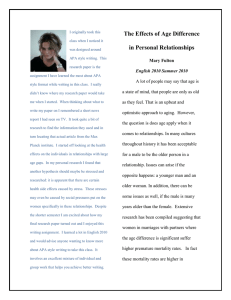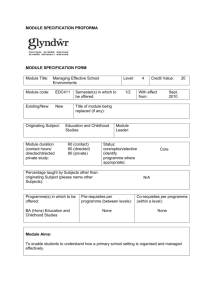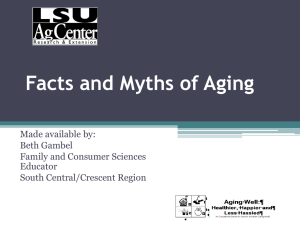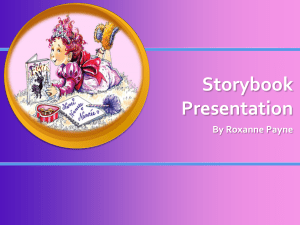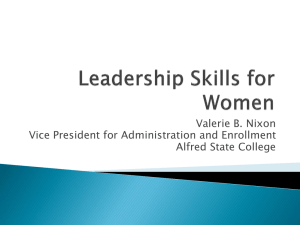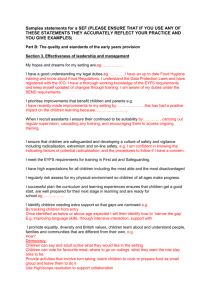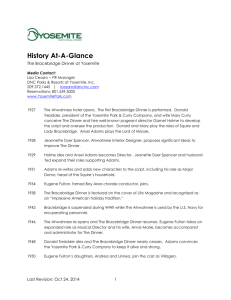Mary Fulton
advertisement
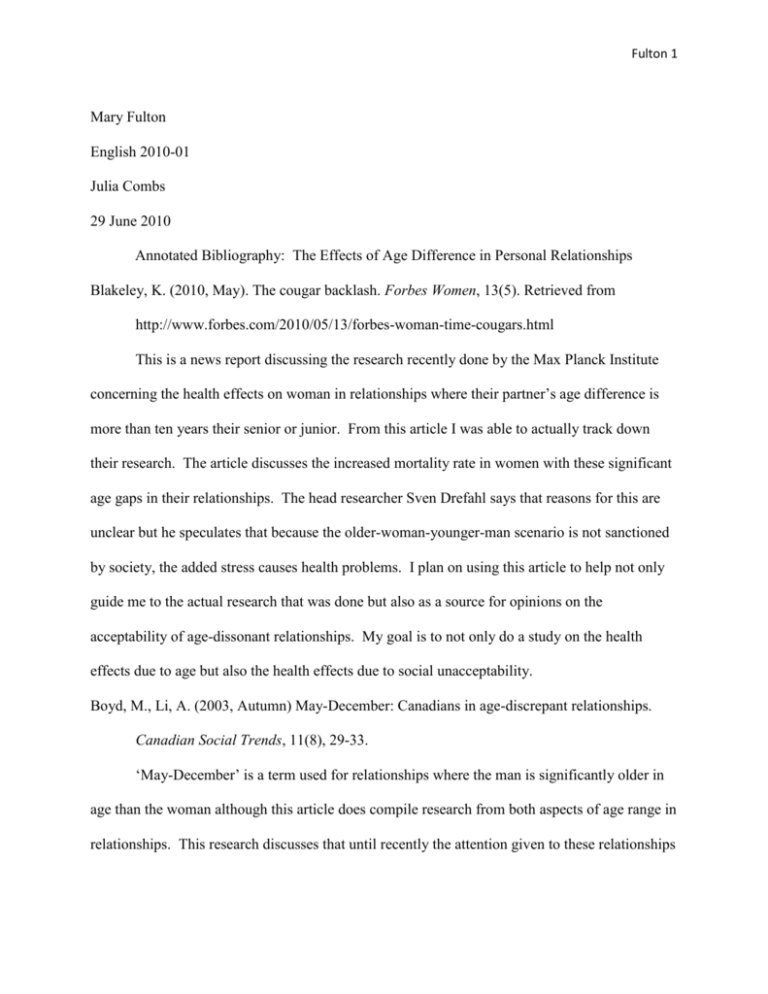
Fulton 1 Mary Fulton English 2010-01 Julia Combs 29 June 2010 Annotated Bibliography: The Effects of Age Difference in Personal Relationships Blakeley, K. (2010, May). The cougar backlash. Forbes Women, 13(5). Retrieved from http://www.forbes.com/2010/05/13/forbes-woman-time-cougars.html This is a news report discussing the research recently done by the Max Planck Institute concerning the health effects on woman in relationships where their partner’s age difference is more than ten years their senior or junior. From this article I was able to actually track down their research. The article discusses the increased mortality rate in women with these significant age gaps in their relationships. The head researcher Sven Drefahl says that reasons for this are unclear but he speculates that because the older-woman-younger-man scenario is not sanctioned by society, the added stress causes health problems. I plan on using this article to help not only guide me to the actual research that was done but also as a source for opinions on the acceptability of age-dissonant relationships. My goal is to not only do a study on the health effects due to age but also the health effects due to social unacceptability. Boyd, M., Li, A. (2003, Autumn) May-December: Canadians in age-discrepant relationships. Canadian Social Trends, 11(8), 29-33. ‘May-December’ is a term used for relationships where the man is significantly older in age than the woman although this article does compile research from both aspects of age range in relationships. This research discusses that until recently the attention given to these relationships Fulton 2 was negative. They were looked upon as father-daughter or mother-son relationships. These unions were considered to be fraught with problems where power issues and clashing values would be obvious due to being raised in different generations. The study however debates this view point. In an extensive research done in Canada they found that major problems in agediscrepant relationships were due to either ethnic differences or financial circumstances— primarily poverty. They verify the studies done by Max Planck institute in that older men with younger women tend to live longer than their counterparts. However, in this article they analyze several studies where age difference has little or no effect on the levels of marital satisfaction that in fact the pressures on the couple from outside sources can sometime create a rift where none existed. I plan to use this article in helping me formulate the survey I plan to conduct on the local societies view on such relationships. The researchers address several questions that will help aid me in my research. Are older-man-younger-woman relationships more acceptable than older-woman-younger-man? What age gap and at what age of the individuals involved change the view point of the individual questioned? If it is acceptable, what are the most common reasons? And if the individual being surveyed finds age-dissonant relationship unacceptable, why do they and under what conditions? I hope to see if the survey from different groups shows a direct effect on societal pressure to such a couple and if the added stress may be a result of the found health risks involved. Brizendine, L. (2010) The male brain. New York, New York: Random House, Inc. In the book “The Male Brain” Dr. Brizendine analyzes the effects of hormone changes in males as they get older. These hormone changes have a direct effect on the way they interact as they get older or at least how they respond to certain situations. In her studies she shows that Fulton 3 certain hormones and their response to others can directly tie into relationship problems and or happiness. Her main case study I found interesting and plan to use in my paper was about a client of hers, a fifty-eight year old man who was in a relationship with a woman over twenty years his junior. She carefully documented his health, changes in energy, wants and desires. She also documented two interesting clashes that came up in this very relationship. The first being the obvious anger that his daughter—who was only six years younger than his new girlfriend— was displaying toward the relationship. Another interesting aspect I plan to look into in my paper is his reaction upon his younger girlfriend expressing a desire to have their own children. Over the next few months they broke up, but realizing he was in love with this woman decided that having a new family wouldn’t be such a bad idea. Dr. Brizendine also states the health benefits—for men in particular—to be in a family. This aspect of prolonged life in men with solid families gives me another avenue for my research. Brizendine, L. (2006) The female brain. New York, New York: Random House, Inc. This being the first book written by Dr. Brizendine she addresses the other aspect to my research with her recent book “The Male Brain”. In hormone levels and desires between men and women, and in analyzing these changes in desires due to hormone balances or imbalances throughout life it actually makes you wonder why age-different relationship are not more common? Women approaching their mid-thirties actually have similar reactions to love, trust and comfort that men do in their mid-fifties. Another interesting part of the book is her case study on a female client, perimenopausal, who now had hormones telling her she was done taking care of everyone. Her brain is now telling her to adventure out, go back to school and pursue her dreams. She could potentially even run into a man twenty years her junior with—in Fulton 4 coinciding with the other book—hormones addressing the same kinds of wants and desires. Between the two books there is actually a lot of information studied scientifically as to how these two completely different people can interact so perfectly. I will use this information in my paper to present a case as to why it can work and the reasons why it may not work. In approaching my topic prior to this resource, I felt for sure that age-dissonant relationships work on rare occasions. The generation gap is too big and clashing and negative endings are inevitable. What Dr. Brizendine’s scientific research suggests is that it is totally possible so again the question I want answered—why are their such extreme health issues if scientifically it should work? What roles do our families, friends and society play in our choice in happiness and health? Drefahl, S. (2010) How does the age gap between partners affect their survival?. Demography, 47(2), 313-329. doi:10.1353/dem.0.0106 In this article researcher Sven Drefahl uses data from marriages with differing age gaps from both men and women over eighty-seven years from 1920 to 2007. His goal was to analyze the age difference between partners and the affect on their survival. He develops some pretty strong hypotheses about the relationship between the spousal age gap and the risk of dying. For men the findings regarding age gap to the spouse are relatively consistent, male mortality rate increases when the wife is older and decreases when the wife is younger. He hypothesized that the due to care giving and youth the morality rate for women in the same situation would be similar however in his research he observed the opposite for women. Despite which direction the age gap, younger-men-older-women or older-men-younger-women, the larger it becomes the greater the mortality rate for the women. Why in the situation of age-dissonant relationships does it only affect women negatively? His direct conclusion is the social implications and I plan Fulton 5 to use his ideas—on a smaller scale—in order to look into the possibilities of these effects. The graphs that are contained within his research are strongly going to help my research paper due to the length and detailed information obtained. The research was extremely thorough having been completed in Denmark where individuals upon marriage are all coded similarly to our Social Security numbers and system. Kemkes-Grottenthaler, A. (2004) For better or worse, till death do us part – spousal age gap and differential longevity: evidence from historical demography. Collegium Antropologicum, 28, 203-219. Retrieved from http://www.collantropol.hr/vol28_id=166 Marital status has gained renewed interest from demographers, epidemiologists and anthropologists due to the mounting evidence that an individual’s marital status may have a direct effect on their mortality rate. They bring in a comparison of the percentage increase in significant women spouse older marriages and the increase in significant male older spouse marriages. They take into effect history from the year 1688 to current in Europe, and also include information on how long the spouses lived and in what occupations they held. In their research they backed up the information I already had with more extensive research. Females who married younger men exhibited longer life spans than females who married older spouses. Similarly, men who married younger died later or lived longer than those who married women older than themselves. Even as far back as 1688 in Europe the health benefits to males existed where there were no benefits to females. I plan to use this to see what information I can find on the social acceptability to women-older marriages throughout the centuries. The even discuss families and the event of children in these various age-dissonant relationships.
